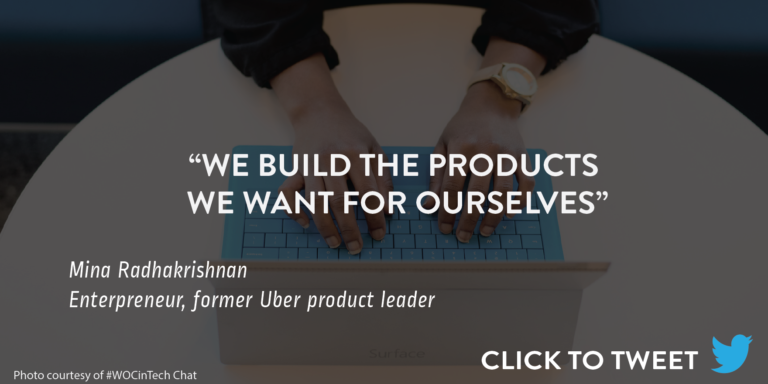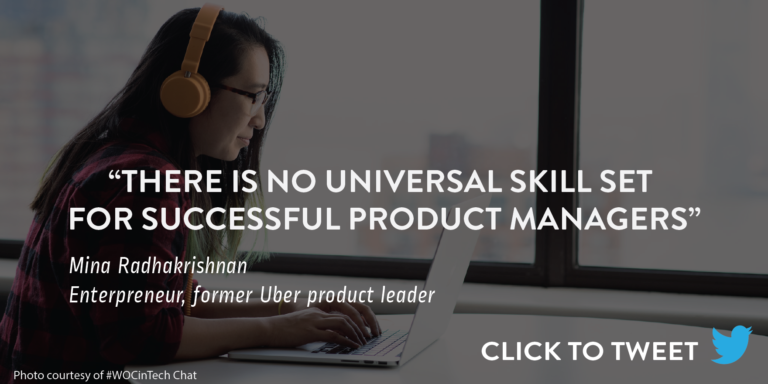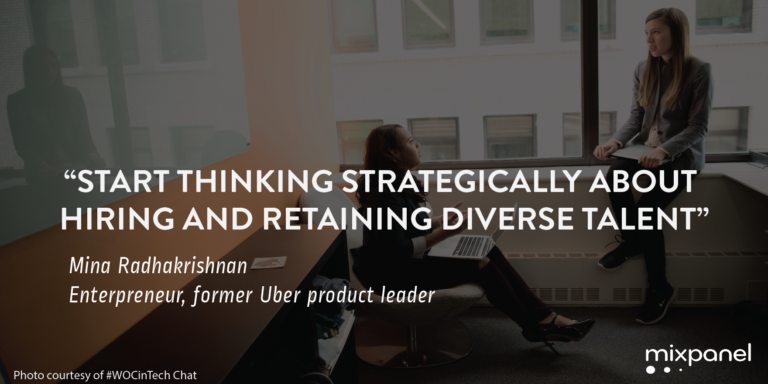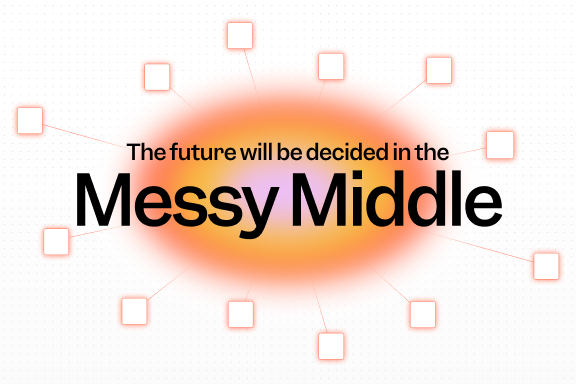Product teams need diverse talent to thrive
Mina Radhakrishnan didn’t want to build a product that made its mark by solving a problem for the affluent. After eight years ensconced in the Bay Area tech bubble – working as a product manager at Google and then leading product at Uber – Mina had watched startup after startup earn its funding by catering to people who can afford convenience.
The trend didn’t surprise her. In fact, it intuitively made sense. “Most product people build the products they want for themselves,” Mina says. “And most VCs are so overwhelmed by the volume of companies they have to review that they focus on the ones they immediately understand, founded by the people already connected to their networks.”
These founders and the venture capitalists who back them are likely acting on a cognitive bias that most of us fall prey to when we don’t have enough information: we imagine things we’re familiar with or fond of as better.
In a place like Silicon Valley – where young people, white people, men, and graduates from elite colleges are grossly overrepresented – this bias drastically limits the number, scope, and potential customer base of viable startups.
However, it’s possible to leverage our predisposition for the familiar for good. “There is nothing wrong with tackling the problems that we see in front of us – those are often the ones we’re best equipped to solve. But when only certain kinds of people get a slice of the pie, the same kinds of products get built. Conversely, the more identities, backgrounds, and experiences represented by founders and product managers, the more problems solved, the more user perspectives understood, and the more products launched by teams who have a handle on how the world will receive them.”
Nearly a decade working on product teams at some of tech’s most sought-after companies gave Mina insight into what it takes to build diverse product teams and how diversity can drive lasting product success. She also saw the ugly underbelly of homogeneity: what happens when the same kinds of people build the same kinds of product for the same kinds of users. (Seriously, look up the founders for the top meal box subscription services available in San Francisco – it’s truly eerie).
To stop this cycle and bring fresh ideas back into the so-called innovation sector, product leaders have to start sourcing and retaining diverse talent. In this exclusive article, Mina explains why companies should prioritize diversity and what each of us can do to make it happen.

Echo chambers do not produce good products – and hinder the creation of great ones
No single product manager can understand every segment of their user base or accurately predict how each new feature will be received, and no one should expect that of them. In fact, according to Mina, product managers often find themselves in hot water not because they don’t know something but because they assume they know what they actually don’t.
“Product managers – myself included – often fall into the trap of thinking that our own experience of the product will match how everyone experiences it. That mindset prevents us from building the kinds of features that would allow us to reach and serve new kinds of users.”
Developing empathy for users can help break this habit, but constant perspective-taking is not possible when PMs have to move quickly to deliver on their roadmap. Moreover, no matter how hard people try, there will always be perspectives they can’t anticipate or understand.
“To catch mistakes, fill gaps, and build a product that resonates with users, product managers have to surround themselves with people with identities, backgrounds, and experiences different from our own. If we only share our ideas with people like us, no one will notice what we miss. Homogeneity is kryptonite to a product team.”
Unfortunately, even product leaders who think they value diversity often deprioritize it and end up with a team sourced entirely from their own networks. This sets the stage for potentially devastating consequences. “If you’re asking yourself, ‘How did I not notice this fatal flaw?’ it’s probably too late.” According to Mina, founders and product people need to seek out diverse inputs from the ideation stage – “otherwise the product will be or rapidly become out of touch.”
Mina gives the example of Bodega, the glorified vending machine startup founded by two ex-Googlers that immediately sparked backlash after it was profiled in Fast Company. “Clearly, those guys didn’t have the same language, lifestyles, or cultural staples as their audience. But how many other people listened to that pitch? How many advisors, investors, family, and friends did they share their idea with? Likely dozens. The fact that they still thought it was a good idea after all that speaks to the lack of racial, cultural, and socioeconomic diversity in Silicon Valley.”
The Bodega problem is magnified when considered alongside the kinds of viable products the majority of VCs choose not to fund, like those built by black women, or ones that target mothers.
“Who we are shapes what we think is valuable. My friend’s firm chose to invest in a company that sells hair extensions for black women. But it took so many conversations to get to the point where they got funding because VCs didn’t see market fit. Not because there isn’t a market, but because they don’t have enough black women on their teams or in their lives to recognize that a massive, untapped one exists.”
Startups like Walker Brands, which makes health and beauty products for people of color, and Naya Health, which makes smart breast pumps, have recognized these opportunities and pursued them. Though consumers have already expressed a desire for the products they are building, these companies have struggled to get the same kinds of funding that doomed startups like Bodega secure easily. The culprit? The overrepresentation of white men in VC.
And it’s not just our race, gender, and socioeconomic background that shapes how we think makes a valuable product or feature. “I have worked on many teams that had PMs of all different abilities. On multiple occasions, I put buttons on an app that had the same color, and it took someone who was colorblind on the team saying something for me to realize that many of our users couldn’t distinguish the yes button from the no button.”
Even a product leader like Mina, who constantly reminds herself to take the diverse experiences of her users into consideration, still can’t catch all her own mistakes. “It’s foolish to assume that we can see everything, or even to assume that we see what we see accurately. And we pay attention to what we pay attention to because of what we think is important. That’s why we have to surround ourselves with people who pay attention to what we don’t. We will all eventually mess up, but diverse teams can set each other back on the right track when we do.”
Diverse product teams have a 360-degree view of user experience
Part of the necessary work of seeding and growing diverse teams is considering what other skills, backgrounds, and experiences contribute to building the product at hand.
“It might seem obvious, but it’s worth saying that what is required for a product management job varies based on the product. There is no universal skill set for successful product managers. If a team needs to build a very complicated dispatch system, then the hiring manager will probably want to bring in someone with a technical background rather than a design background. But if the team needs to build a user-friendly consumer product, a design background is more important.”

The teams Mina led at Uber needed a mix of product managers with technical backgrounds and others with operational ones. “We built a number of products that our users never interacted with directly. Those really beautiful apps for drivers and riders were only 20% of the puzzle. The other 80% was everything that our users didn’t see – everything running in the background that made it possible to just press a button and get a car. It feels so easy, because of all the hard work that operations had to do behind the scenes.”
The cross-functional new driver app team is a shining example of what a diverse product team can accomplish that others cannot. “One of the mistakes we had made with building the initial driver app is that we only looked at the demographics of our drivers, but we didn’t think about a basic fact of working in service: it’s stressful. Especially when you’re driving a car. And the way people respond to stress is totally different. Some find it motivating, while others freeze up.
The PM on our team who built a new driver app made sure to assemble a broad team. Because people on that team had different responses and histories with stress, they could assess what it’s like for drivers when they’re in the middle of the ride and suddenly there is a massive beeping noise in the car. While helpful for some, this kind of alert might totally freak out other drivers. Luckily, the team had someone empathetic enough to ask that question and think about the driver who has been working for hours and just wants to go home.”
For that reason, Mina sought out product managers with operational backgrounds, who ultimately proved incredibly important to the success of the team at Uber. “We needed someone who could answer the question: ‘How can we make this product work for a user who has to be on it a hundred times a day?’ And not just answer the question, but have the sense to ask it, too.”
For one of Mina’s teams, that person was Emily. “We would not have hired her if we had stuck to the traditional requirements for a product manager, but we also wouldn’t have created some of the really fantastic products that we did without her. She ran driver operations in Chicago, and I’ve never seen anyone work or hustle as hard as Emily or pick up the technical skills she needed so quickly. On top of that, she had this invaluable knowledge about our drivers: what they think about, what they want, what they struggle with. So she could build the right product for them.”
Over time, Mina saw all the product managers on the team learning from each other and adopting a wider range of perspectives. “Working on a team with a diverse group of people forces everyone to be more empathetic because they can’t assume they know what the other team members want or what they think. You’re consciously thinking about it on a day-to-day basis. It forces empathy and conscious communication, and when you’re doing that and thinking about that, it becomes part of the way you build products.”
The nitty-gritty of prioritizing diversity on product teams
At one point or another, most product leaders make mistakes that prevent them from building the kind of diverse product teams they set out to build. Mina admits hers readily. “I have tried and failed with diversity and inclusion many times. On one team, I set a gender ratio goal. In retrospect, that was a total intersectionality no-no because it’s not just about gender, it’s about underrepresented groups in general. If a product team is just hiring white women, they haven’t made a dent when it comes to diversity. They’ve just built a different kind of echo chamber.”
These and other lessons Mina learned from failure. She shared the following four with us.
Cut the cord with technical degree requirements.
As a product manager with an engineering background, Mina had to wean herself off the idea that technical degrees from prestigious schools make for better PMs. “Most people who fit that criteria are white men. Hiring managers who make unsaid criteria out of the ‘pedigree’ of a person’s alma mater or previous employers will likely weed out qualified candidates before they make it to the first round of interviews. More often than not, those candidates will be from underrepresented groups in tech.”
Mina’s experience leading product teams has shown her that not every PM needs exceptional technical skills to thrive on a product team. “There should be a healthy mix to encourage people to learn from one another and fill gaps where others can’t. Not every PMs needs to excel in every task required of product – that’s why there is a team.”
Ask better questions.
In order to hire product managers with a diversity of experiences, Mina prepares questions that prompt candidates to talk about their life outside of the workplace. One of the most important qualities Mina looks for in a PM is product curiosity, an essential trait that – among the most effective PMs – tends to filter into their daily lives.
“I ask people a very simple question during interviews: what is your favorite physical product? I think it gets at the heart of people’s tastes and creativity.” Mina looks for people who think outside of the tech bubble because, in order to innovate, product people have to go beyond what’s already being done.
“The conversation tends to end quickly after anyone says iPhone or Macbook. Because what I’m really looking for is their answer to the ‘why’ and there is nothing anyone can tell me about either of those products that hasn’t already been included in hundreds of think pieces. It’s much more interesting when people talk about what’s personal to them. People have talked about amazing hair straighteners and the Rabbit corkscrew – it doesn’t really matter. What I want to hear in the answer is a pitch that speaks to what they find uniquely valuable about a product.”
For Mina, it has served as a great proxy for a creative mind. “Every single one of the product hires on the new driver app team had a fantastic answer to that question.”
Develop an inclusive leadership strategy.
Product leaders who want to hire and retain diverse talent need to build their leadership strategy around that effort – not just make one-off attempts here and there. Mina recommends starting with hiring by committee, building out cross-functional teams, and amplifying the voices of quieter team members.
“Maybe I’m naive, but I don’t think any product leader is actively trying to build exclusive, homogeneous teams. And yet, there are a lot of them. To start closing that gap, product managers should make sure they have an interview panel that is as diverse as the team they want to build. Cross-functional teams help with that. Typically engineering teams don’t have much diversity, but if there is also a designer and a customer support person and a copywriter and a financial analyst, it’s more likely the team will be more diverse.”
To keep that team diverse, product leaders have to invest in inclusion – as much, if not more, than they invested in diversity. “As a manager, it’s critical to make sure no one is being dismissed or shut down. At the end of my meetings, I review the conversation to make sure everyone has had enough airtime. This might seem easy enough, but at a smaller company, where leaders are overwhelmed, many let it fall by the wayside. Ask: ‘Am I letting this go because I have too many things on my plate?’ Most of the time that’s the reason, so we have to make time and create the space to make the change.”
Cultivate intention.
To make sure they prioritize diversity and inclusion on the day-today, product leaders need to practice self-awareness. It sounds simple enough, but from Mina’s perspective, the real work is taking the time and energy to self-educate, research, and reflect. “Understand your biases so you can get ahead of them, while also recognizing that you will eventually screw up. Just make sure that the screw up doesn’t become the moment that you give up.”
From Mina’s perspective, it’s thoughtlessness – not malice – that gets in the way of diversity efforts. “As product managers, we think strategically about our product roadmaps, but tactically about everything else. It’s time to start thinking strategically about hiring and retaining diverse talent and building inclusive communities. If you make it another task on your list, it won’t happen.”
When leaders like Mina make it their mission, it does.

Building Different.com.au differently
A few years ago, Mina took what she learned from Silicon Valley and then left it. After seeing the threat that myopia posed to innovation, Mina decided she wanted to start her company elsewhere, far away from the Bay Area.
“I knew I wanted to build something different – a product that would solve a problem for people who hadn’t otherwise benefitted much from technology,” Mina says.
She went about as far as she could get to do it. After wading through the long list of startup ideas that she and her husband had generated over the years, they landed on one that had legs. If they did well, the product would make major advancements in an industry that hadn’t changed in decades: property management in Australia.
Over the phone, Mina described the problem in detail. “In Australia, 10% of all people own an investment property. Unlike in the US, a significant portion of those owners is not wealthy. Many of them are middle-class, and their property is their only path to retirement. But because most of them still work full-time, they have to spend a significant portion of what they’re trying to save to hire a professional property manager who can interface with the tenant and deal with upkeep.”
While reviewing her in-laws’ finances to prepare them for retirement, Mina discovered the fees that their property management company had charged them over the past two decades had continued to increase without any reason. When she asked him about it, her father-in-law said they didn’t really have a relationship with their property manager or know exactly what they did. The company sent over someone new every nine months like clockwork.
“This conversation was my ‘aha’ moment. I saw people I loved spending their retirement income on poor service, and I felt we could offer a great one.” After talking to more owners, tenants, and property managers, Mina and her husband saw a clear need for a local, specialized product that could eventually have global potential.
Thus, Different.com.au began, borne out of Mina and her husband’s desire to solve an immediate problem for someone they love. The similarities between their decision-making process and that of the founders and VCs in Silicon Valley are not lost on Mina. In fact, those similarities get to the heart of why she shared this story in the first place.


